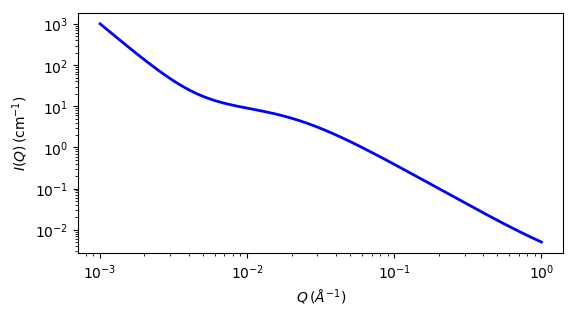correlation_length
Calculates an empirical functional form for SAS data characterized by a low-Q signal and a high-Q signal.
| Parameter | Description | Units | Default value |
|---|---|---|---|
| scale | Scale factor or Volume fraction | None | 1 |
| background | Source background | cm-1 | 0.001 |
| lorentz_scale | Lorentzian Scaling Factor | None | 10 |
| porod_scale | Porod Scaling Factor | None | 1e-06 |
| cor_length | Correlation length, xi, in Lorentzian | Å | 50 |
| porod_exp | Porod Exponent, n, in q^-n | None | 3 |
| lorentz_exp | Lorentzian Exponent, m, in 1/( 1 + (q.xi)^m) | None | 2 |
The returned value is scaled to units of cm-1 sr-1, absolute scale.
Definition
The scattering intensity I(q) is calculated as
The first term describes Porod scattering from clusters (exponent = n) and the second term is a Lorentzian function describing scattering from polymer chains (exponent = m). This second term characterizes the polymer/solvent interactions and therefore the thermodynamics. The two multiplicative factors A and C, and the two exponents n and m are used as fitting parameters. (Respectively porod_scale, lorentz_scale, porod_exp and lorentz_exp in the parameter list.) The remaining parameter ξ (cor_length in the parameter list) is a correlation length for the polymer chains. Note that when m=2 this functional form becomes the familiar Lorentzian function. Some interpretation of the values of A and C may be possible depending on the values of m and n.
For 2D data: The 2D scattering intensity is calculated in the same way as 1D, where the q vector is defined as

Fig. 96 1D plot corresponding to the default parameters of the model.
Source
References
- B Hammouda, D L Ho and S R Kline, Insight into Clustering in Poly(ethylene oxide) Solutions, Macromolecules, 37 (2004) 6932-6937
Authorship and Verification
- Author: NIST IGOR/DANSE Date: pre 2010
- Last Modified by: Steve King Date: September 24, 2019
- Last Reviewed by: